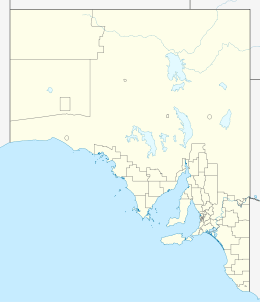Muston, South Australia
| Muston South Australia | |||||||||||||
|---|---|---|---|---|---|---|---|---|---|---|---|---|---|
 Muston | |||||||||||||
| Coordinates | 35°48′27″S 137°44′06″E / 35.8075°S 137.735°ECoordinates: 35°48′27″S 137°44′06″E / 35.8075°S 137.735°E | ||||||||||||
| Population | 560 (shared with other localities in the “State Suburb of Nepean Bay”) (2011 census)[1][lower-alpha 1] | ||||||||||||
| Established | 2002[2] | ||||||||||||
| Postcode(s) | 5221 [3] | ||||||||||||
| Time zone | ACST (UTC+9:30) | ||||||||||||
| • Summer (DST) | ACST (UTC+10:30) | ||||||||||||
| Location | |||||||||||||
| LGA(s) | Kangaroo Island Council[2] | ||||||||||||
| Region | Fleurieu and Kangaroo Island[4] | ||||||||||||
| County | County of Carnarvon[2] | ||||||||||||
| State electorate(s) | Finniss[5] | ||||||||||||
| Federal Division(s) | Mayo[6] | ||||||||||||
| |||||||||||||
| |||||||||||||
| Footnotes |
Coordinates[2] Locations[3] Climate[7] Adjoining localities[2] | ||||||||||||
Muston is a locality in the Australian state of South Australia located on Kangaroo Island overlooking the coastal lagoon known as Pelican Lagoon about 127 kilometres (79 mi) south-west of the state capital of Adelaide and about 21 kilometres (13 mi) south-east of the municipal seat of Kingscote.[2][3]
Its boundaries were created in March 2002 for the “long established name” which was derived from Arthur Muston, the founder of the Colonial Salt Company which became the Commonwealth Salt Refining Company in 1905.[2][8][9] A railway line which operated from 1910 to 1954 passed through what is the locality from a salt mining operation at Salt Lake in what is now the adjoining locality of Haines moving salt to a now-demolished jetty on the Pelican Lagoon coastline where it was loaded and shipped to Edithburgh for refining. [10]
Muston is bounded by the American River Road in part to the west, the Hog Bay Road to the south and by the coastline with Pelican Lagoon in part to the east.[2] The principal land use in the locality is primary production with a strip of land on the coastline being zoned both for conservation and as a settlement described as a ‘rural living precinct’.[11][2]
Muston is located within the federal division of Mayo, the state electoral district of Finniss and the local government area of the Kangaroo Island Council.[6][5][2]
See also
References
- Notes
- ↑ For the 2011 census, the ‘State Suburb of Nepean Bay’ consisted of the localities of Ballast Head, Birchmore, D’estrees Bay, Haines, Kohinoor, MacGillivray, Muston, Nepean Bay, Seal Bay and Seddon.
- Citations
- ↑ Australian Bureau of Statistics (31 October 2012). "Vivonne Bay". 2011 Census QuickStats. Retrieved 21 April 2016.
- 1 2 3 4 5 6 7 8 9 10 "Search result for "Muston (Locality Bounded)" (Record no SA0048216 with the following layers selected - "Suburbs and Localities", "Place names (gazetteer)", "Road Labels" and "Development Plan Layers"". Property Location Browser. Government of South Australia. Retrieved 28 August 2015.
- 1 2 3 "Postcode for Muston, South Australia (Postcode)". postcodes-australia.com. Retrieved 31 October 2016.
- ↑ "Fleurieu and Kangaroo Island SA Government region" (PDF). The Government of South Australia. Retrieved 9 September 2016.
- 1 2 "District of Finniss Background Profile". Electoral Commission SA. Retrieved 2 August 2015.
- 1 2 "Federal electoral division of Mayo, boundary gazetted 16 December 2011" (PDF). Australian Electoral Commission. Retrieved 2 August 2015.
- ↑ "Monthly climate statistics: Summary statistics KINGSCOTE (nearest station)". Commonwealth of Australia , Bureau of Meteorology. Retrieved 20 April 2016.
- ↑ Manning, G.H. "Muston, Nomenclature". Place names of South Australia. State Library of South Australia. Retrieved 31 October 2016.
- ↑ "THE ONLY AMERICAN RIVER.". The Register (Adelaide). LXXIX, (20,990). South Australia. 19 February 1914. p. 6. Retrieved 31 October 2016 – via National Library of Australia.
- ↑ Collins, Neville C (2005), The jetties of South Australia : past and present, Neville Collins, p. 222, ISBN 978-0-9580482-2-4
- ↑ "Development Plan, Kangaroo Island Council, Consolidated – 20 February 2014" (PDF). Government of South Australia. pp. 114, 152, 169 and 290–295. Retrieved 8 March 2016.